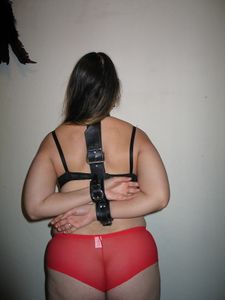Elbow bondage
|
Elbow bondage is a technique used in BDSM play involving the restraint of a person's elbows by binding them close together behind the person's back, thus greatly restricting use of the arms. (If the wrists are also tied together, the arms are rendered still more useless.) It also stops the person bringing his or her hands to the front by maneuvering the bound wrists over the feet.
The method of restraint can vary greatly, as does the degree to which a person's elbows can be drawn towards each other. Typical equipment for binding a person may include ropes, leather straps, leather cuffs, monogloves, handcuffs or chains. The classic style of "perfect" elbow bondage is to have the person's elbows bound together, touching, behind the back, and secured with rope—a feat possible only for flexible, healthy people, and generally easier for women than for men.
See also [ Arm binder ]
The reasons for using elbow bondage in BDSM can be divided into two categories: the visual appeal of having the body contorted by such a position, and the physical restraint, for it is very difficult, if not impossible, to free oneself from elbow bondage even if the lower arms and wrists are free. The location of the bindings, combined with the degree to which the arms are pulled together, makes any attempt to free oneself very difficult without help. (For this reason, elbow bondage can very easily go wrong when used in self-bondage.)
Aesthetic
When applied to a woman, this method of restraint causes the chest and breasts to be thrust forward, emphasising these features. Combining this with other bondage techniques, such as breast bondage, can further enhance this effect. By having the arms bound close behind her, a woman's narrow waist is emphasised, creating a well-defined hourglass figure. A tight corset can greatly enhance this effect.
The sight of the arms bound so securely behind the back has a strong erotic appeal to many in the BDSM community, derived from the almost absolute inescapability of the restraint in question and the helplessness of the bound person.
Techniques
Some argue that rope is the preferred material for elbow bondage, because it enables the arms to be held very close together, while spreading the pressure of the binding over a large area, as well as having a very strong visual and "artistic" feel from the neat and intricate ropework that may be used.
Other methods might utilise leather straps, a leather body harness, or both. Both of these methods can be used to bind a person into elbow bondage very quickly, and allow quick release, and so are particularly useful when the person being bound is unable to maintain this position for very long without distress or even injury.
Leather cuffs are quick to attach and release, but usually, being separated by a flexible link, don't work for the "elbow touching elbow" look. In addition, because they allow extra movement, the ability to escape from such restraints is much greater. These issues also arise with metal cuffs.
Chains are also often used as a securing method, but can cause problems and even damage to the tissues around the elbows caused when they apply uneven or too great pressure. The most "comfortable" method of elbow bondage is to use a monoglove or armbinder. Usually made of leather, this garment is V-shaped; the arms are inserted down into it. Lacing or a zipper closes the garment around the arms, drawing them together evenly down its full length. When secured correctly, this method of bondage can also be highly inescapable, as it is impossible to use the fingers to locate and release strapping, ropes, etc.
Precautions
As in any form of BDSM play, a person in elbow bondage is at risk of injury. Typical safety advice is that a person who is bound should never be left alone for long, particularly in tight bondage, such as having the elbows tied. Of greatest risk is the cutting off of blood circulation to the lower arms. A radial and ulnar arteries pass very lose to the skin just above and below the elbows, and a rope or chain that is poorly placed can place pressure on this area. When this happens, numbness spreads rapidly throughout the arms, followed by sharp, shooting pain. Repetition can cause permanent damage to the tissue, the circulation, and the nerves.
Having the arms bound tightly behind the back can also cause ligament damage to the upper arms and shoulder joints, as well as muscle damage to the upper back and neck areas. If a person is not flexible enough for the elbows to meet behind the back, it should not be attempted initially, but restaints should be looser instead; over time, the flexibility may increase, allowing the elbows to be drawn ever closer. It is important to note that this only applies to someone who is fit, young, and healthy, and who has no medical conditions that may cause issues with this; persons with multiple sclerosis or arthritis, for example, should not be subjected to this technique. In older and/or less fit persons, the muscles and ligaments are less stretchy and unable to adapt to new positions as easily as healthier muscles; in such a person, a ligament could easily be torn, and worse could happen.
If lying prostrate, a person with arms bound tightly behind the back will have great pressure exerted on the diaphragm, causing increased effort to maintain breathing. (See Positional asphyxia.) If the person is also gagged in some manner, the difficulty may be even greater. It is typically argued that, for safety, a person should never be left alone in such a position.
Elbow harness
Elbow bondage severely restricts movement of the arms, especially if (as is usual) the wrists are also bound. However, further bondage can be used to restrict the movement even more. A common procedure is to tie ropes round the arms and torso; on a woman, these can be linked to ropes for breast bondage. Another procedure is to take a rope from the wrist binding through the crotch and fasten it to the front of a belt or rope round the waist, or the front of a corset. If elbow bondage is combined with a hogtie, this should itself immobilise the arms. For maximum immobility, ropes round the torso can be used as well as a hogtie or crotch rope.
If the wrists are not bound, they can be placed on the bound person's waist and then the wrists can be linked by rope or handcuffs across the stomach. The closer the elbows are together, the longer must be the link across the stomach.
- Armbinder/Monoglove pictures
Chat rooms • What links here • Copyright info • Contact information • Category:Root



